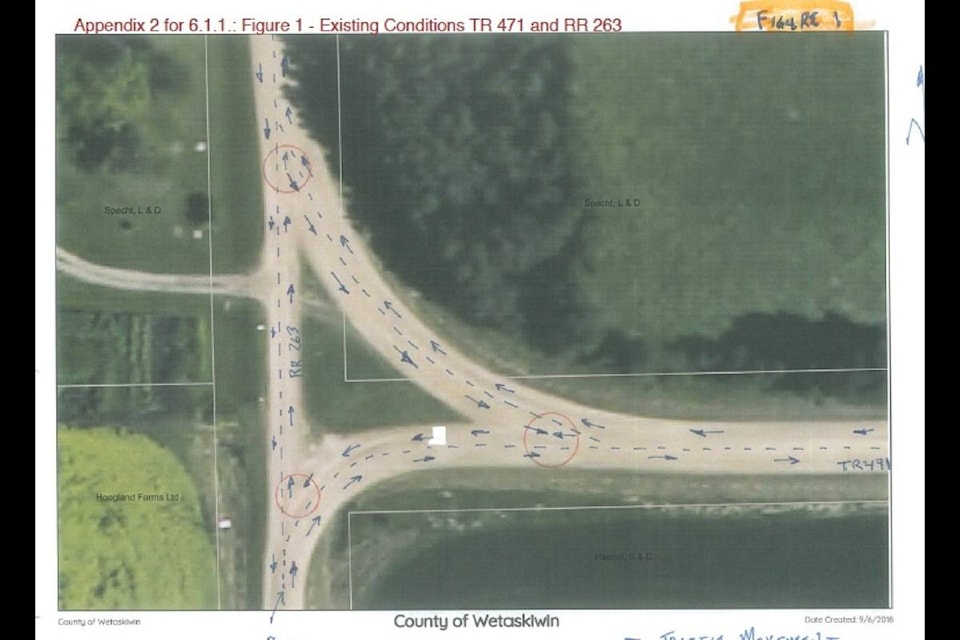The issue of removing gravel road speed curves in certain parts of the County of Wetaskiwin returned to council at their Public Works meeting Oct. 9.
At the Sept. 11 council meeting a Pipestone area resident, Leon Specht, spoke to council about a Public Works program to remove certain speed curves on gravel roads in different areas of the county.
Public Works manager Neil Powell noted that some of the curves were on private land and all of them were a safety concern. He showed a map of one of the curves and the confusing nature of right-of-way they created. While council decided to allow the Public works program to run its course.
Specht on Sept. 16 organized a community meeting in the Pipestone and Porto Bello areas to get input from residents who would be affected by that curve’s removal. Of 34 people present, 33 stated they wanted the curve to remain. Specht subsequently stated residents would attend an upcoming council meeting.
About two dozen people attended the Oct. 9 Public Works meeting. Specht and Murray Kemp acted as spokespersons.
Powell spoke first and reiterated what he said to councilors previously. Powell stated he examined the curves himself in the field and from his experiences, he considered the curves unsafe, especially if someone from out of the region was driving through them.
He stated the right-of-way should always be clear at an intersection, and there’s obviously nothing wrong with “T” intersections because there are hundreds of them in the county. Powell also stated removing the curves wouldn’t necessarily be expensive. “A lot of the work there is not extensive,” said Powell.
Specht stated he also wanted to reiterate everything he said at his previous appearance. Specht noted he’s worked in safety assessment and feels more information is needed before calling the curves unsafe; he noted that low traffic volumes in many of these areas greatly reduce safety concerns.
He stated that each curve removal should be handled separately, because all of the intersections involved are different.
Specht also stated that “adverse possession” should be considered: this is a legal term used to describe a situation where someone is occupying some else’s property, in effect with permission, and after a certain amount of time, the property is assumed to belong to the occupier.
Specht repeated he felt estimates for removing the curves were too low, and the money spent on removing the curves could be better used maintaining gravel roads.
Kemp noted his family farm is located between two of these curves and he is a third generation farmer in the Porto Bello region and regularly uses three of the six curves in that area.
Kemp stated if the curves are removed, his efficiency as a farmer will be impacted, and farming successfully requires great efficiency. He stated visitors should drive carefully. “If I don’t know the area, I drive cautiously,” said Kemp. “I hope everyone would do the same.” Kemp added he felt that public consultation could have been better handled by the county on this matter.
Lastly, Dale Franklin spoke about a curve near his home at the bottom of a hill. He said the curve is useful for keeping the traffic flowing and said removing the curve would be a “disaster.”
Councilor Terry Van de Kraats said he took Powell’s safety concerns seriously. He remembered a crash on the Hillside Road which resulted in the hill being cut down to reduce risk. “Does it take a major collision and somebody passing away?” asked Van de Kraats. “Things do happen. And that’s where I’m coming from.”
Van de Kraats also noted that if efficiency is the prime concern, does that mean more speed curves should be put in? He added that the County of Wetaskiwin is seeing more and more new residents who don’t know anything about these curves.
Reeve Kathy Rooyakkers stated she had one of these curves on her land and it was removed. It takes a bit longer to get around but Rooyakkers stated it seems that the intersection is much more safe. “We still have to take the aspect of safety into effect,” said the reeve.
Councilor Josh Bishop said he’s spent a lot of time looking at these curves and strongly feels they should be treated individually. For example, two of them lead onto dead-end roads with very little traffic.
Rooyakkers stated, if some curves that sit on private land are kept by the county, she would like to see solid cost predictions.
Councilor Ken Adair noted he wanted to see costs for properly identifying the curves. “I’d also like to see the cost on signage,” said Adair.
Councilor Lyle Seely said he didn’t know much about these curves and felt looking at them individually seemed reasonable, but the safety aspect can’t be ignored, especially on the busiest ones.
Bishop felt looking at each curve individually would reveal at least some could be kept as most are not a safety concern. “I don’t buy the safety bit,” said Bishop.
County CAO Rod Hawken commented on the adverse possession idea; he noted that the theory probably didn’t apply because the amount of land involved is extremely small.
Bishop made a motion that the speed curve projects should come to council on a case by case basis and that county staff would report back with costs, including legal costs. It was passed unanimously.
